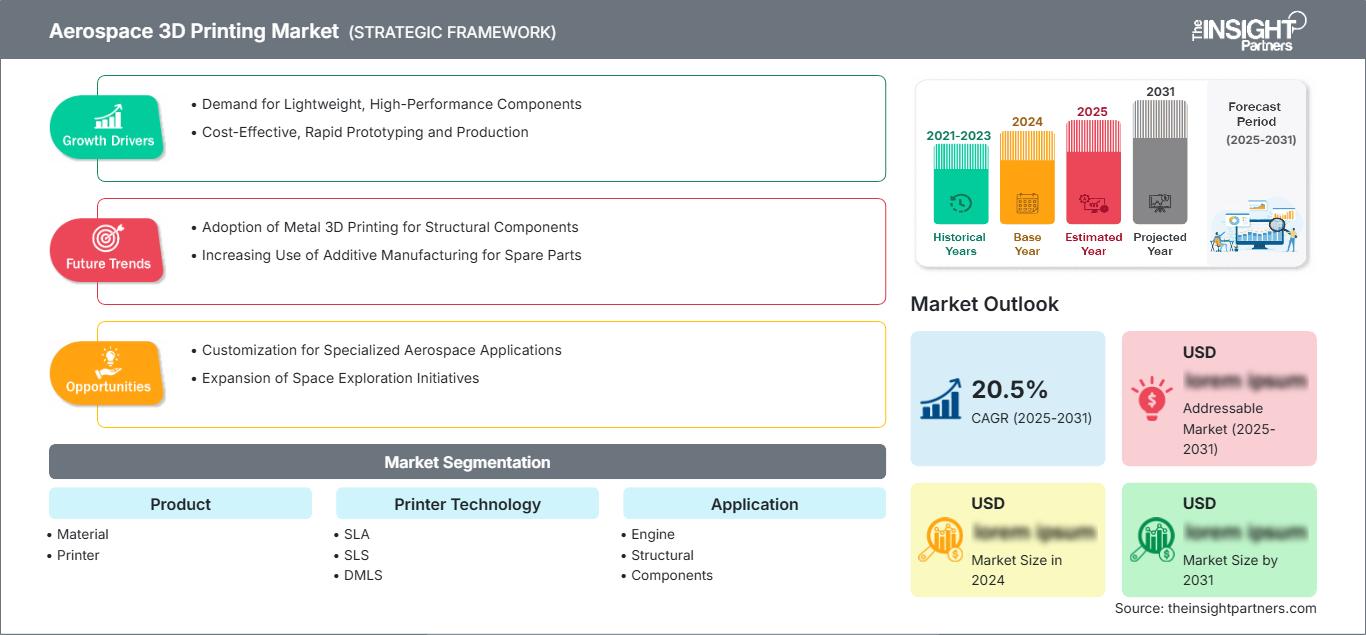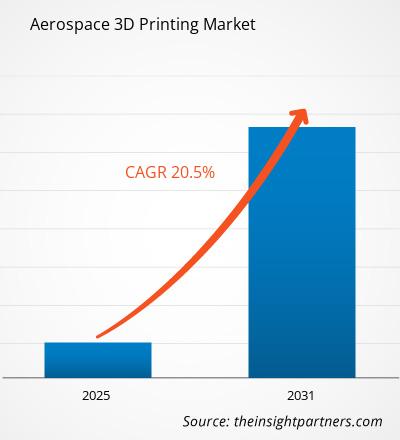Le marché de l'impression 3D pour l'aérospatiale devrait enregistrer un TCAC de 20,5 % entre 2025 et 2031, avec une taille de marché passant de XX millions de dollars américains en 2024 à XX millions de dollars américains d'ici 2031.
Le rapport est segmenté par produit (matériau, imprimante) ; technologie d'impression (SLA, SLS, DMLS, FDM, clip) ; application (moteur, structure, composants) ; utilisation finale (avion, hélicoptère, drone, engin spatial). L'analyse mondiale est ensuite ventilée au niveau régional et par principaux pays. Le rapport offre la valeur en USD pour l'analyse et les segments ci-dessus.
Objectif du rapport
Le rapport sur le marché de l'impression 3D pour l'aérospatiale de The Insight Partners vise à décrire le paysage actuel et la croissance future, les principaux facteurs moteurs, les défis et les opportunités. Cela fournira des informations à diverses parties prenantes commerciales, telles que :
- Fournisseurs/fabricants de technologie : pour comprendre l’évolution de la dynamique du marché et connaître les opportunités de croissance potentielles, leur permettant de prendre des décisions stratégiques éclairées.
- Investisseurs : pour effectuer une analyse complète des tendances concernant le taux de croissance du marché, les projections financières du marché et les opportunités qui existent tout au long de la chaîne de valeur.
- Organismes de réglementation : pour réglementer les politiques et surveiller les activités du marché dans le but de minimiser les abus, de préserver la confiance des investisseurs et de maintenir l’intégrité et la stabilité du marché.
Segmentation du marché de l'impression 3D pour l'aérospatiale Produit
- Matériau
- Imprimante
Technologie d'impression
- SLA
- SLS
- DMLS
- FDM
- Clip
Application
- Moteur
- Composants structurels
Utilisation finale
- Aéronefs
- Hélicoptères
- Drones
- Engins spatiaux
Vous bénéficierez d’une personnalisation sur n’importe quel rapport - gratuitement - y compris des parties de ce rapport, ou une analyse au niveau du pays, un pack de données Excel, ainsi que de profiter d’offres exceptionnelles et de réductions pour les start-ups et les universités
Marché de l'impression 3D aérospatiale: Perspectives stratégiques

-
Obtenez les principales tendances clés du marché de ce rapport.Cet échantillon GRATUIT comprendra une analyse de données, allant des tendances du marché aux estimations et prévisions.
Facteurs de croissance du marché de l'impression 3D pour l'aérospatiale
- Demande de composants légers et performants : Alors que les entreprises aérospatiales s'efforcent de réduire leur consommation de carburant et d'accroître leur efficacité, des pièces légères et performantes sont essentielles. L'impression 3D permet de créer des structures complexes et légères avec des conceptions optimisées que les méthodes de fabrication traditionnelles ne peuvent pas atteindre. Cette capacité à produire des composants personnalisés, très résistants et légers favorise l'adoption de l'impression 3D dans l'industrie aérospatiale, où chaque once de réduction de poids contribue à des économies de carburant et à l'amélioration des performances.
- Prototypage et production rapides et rentables : Les fabricants aérospatiaux se tournent de plus en plus vers l'impression 3D pour réduire les délais et les coûts de production. Les techniques de fabrication traditionnelles impliquent souvent des processus longs et un outillage coûteux, mais l'impression 3D permet un prototypage plus rapide et la possibilité de créer des pièces à la demande. Cela accélère non seulement les cycles de développement des produits, mais réduit également le coût de production de composants complexes, ce qui en fait une solution plus attrayante pour les grandes et les petites entreprises aérospatiales.
Tendances futures du marché de l'impression 3D aérospatiale
- Adoption de l'impression 3D métal pour les composants structurels : l'impression 3D métal gagne du terrain dans le secteur aérospatial, en particulier pour la création de composants structurels. Les technologies avancées d'impression métal, telles que la fusion sélective par laser (SLM) et la fusion par faisceau d'électrons (EBM), permettent la production de pièces métalliques complexes et très durables. Ces matériaux, comme le titane et les alliages d'aluminium, sont essentiels dans les applications aérospatiales en raison de leur rapport résistance/poids et de leur résistance aux conditions extrêmes, ce qui rend l'impression 3D métal de plus en plus populaire pour la production d'avions et de vaisseaux spatiaux.
- Utilisation croissante de la fabrication additive pour les pièces de rechange : la tendance à utiliser l'impression 3D pour la production de pièces de rechange et de remplacements à la demande est en pleine croissance dans l'aérospatiale. Au lieu de maintenir des stocks importants, les entreprises aérospatiales utilisent l'impression 3D pour fabriquer des pièces de rechange selon les besoins, réduisant ainsi les coûts de stockage et les temps d'arrêt. Cette évolution est particulièrement bénéfique dans le secteur de la maintenance, de la réparation et de la révision (MRO), où la livraison rapide de composants critiques est cruciale pour maintenir les avions opérationnels et minimiser les interruptions d'exploitation.
Opportunités du marché de l'impression 3D pour l'aérospatiale
- Personnalisation pour des applications aérospatiales spécialisées : l'impression 3D permet de produire des composants hautement personnalisés, adaptés à des exigences aérospatiales spécifiques, comme des pièces sur mesure pour les drones ou l'exploration spatiale. Cela représente une opportunité significative pour les entreprises aérospatiales de créer des pièces uniques, optimisées en termes de performances, d'ajustement et de fonctionnalité, répondant à des défis de conception uniques. La flexibilité de la fabrication additive en termes de choix des matériaux et de complexité de conception offre un vaste potentiel pour répondre aux besoins spécifiques de l'aérospatiale.
- Expansion des initiatives d'exploration spatiale : Avec l'augmentation des investissements dans l'exploration spatiale et les missions spatiales commerciales, l'impression 3D offre un potentiel croissant pour la production de composants de qualité spatiale. La NASA et des entreprises spatiales privées explorent la fabrication additive pour produire des pièces légères et durables pour les engins spatiaux et les habitats spatiaux. Ce marché présente un potentiel de croissance immense, car l'impression 3D permet de créer des pièces directement dans l'espace, réduisant ainsi le besoin de missions de ravitaillement coûteuses et améliorant l'efficacité globale des opérations spatiales.
Marché de l'impression 3D aérospatiale
Les tendances régionales et les facteurs influençant le marché de l'impression 3D aérospatiale tout au long de la période de prévision ont été analysés en détail par les analystes de The Insight Partners. Cette section aborde également les segments et la géographie du marché de l'impression 3D aérospatiale en Amérique du Nord, en Europe, en Asie-Pacifique, au Moyen-Orient et en Afrique, ainsi qu'en Amérique du Sud et en Amérique centrale.
Portée du rapport sur le marché de l'impression 3D pour l'aérospatiale| Attribut de rapport | Détails |
|---|---|
| Taille du marché en 2024 | US$ XX million |
| Taille du marché par 2031 | US$ XX Million |
| TCAC mondial (2025 - 2031) | 20.5% |
| Données historiques | 2021-2023 |
| Période de prévision | 2025-2031 |
| Segments couverts |
By Produit
|
| Régions et pays couverts |
Amérique du Nord
|
| Leaders du marché et profils d'entreprises clés |
|
Densité des acteurs du marché de l'impression 3D aérospatiale : comprendre son impact sur la dynamique commerciale
Le marché de l'impression 3D pour l'aérospatiale connaît une croissance rapide, portée par une demande croissante des utilisateurs finaux, due à des facteurs tels que l'évolution des préférences des consommateurs, les avancées technologiques et une meilleure connaissance des avantages du produit. Face à cette demande croissante, les entreprises élargissent leur offre, innovent pour répondre aux besoins des consommateurs et capitalisent sur les nouvelles tendances, ce qui alimente la croissance du marché.
- Obtenez le Marché de l'impression 3D aérospatiale Aperçu des principaux acteurs clés
Principaux arguments de vente
- Couverture exhaustive : Le rapport couvre l’analyse exhaustive des produits, services, types et utilisateurs finaux du marché de l’impression 3D aérospatiale, offrant un panorama global.
- Analyse d’experts : Le rapport est élaboré à partir de la connaissance approfondie d’experts et d’analystes du secteur.
- Informations actualisées : Le rapport garantit sa pertinence commerciale grâce à sa couverture des informations récentes et des tendances des données.
- Options de personnalisation : Ce rapport peut être personnalisé pour répondre aux besoins spécifiques des clients et s’adapter aux stratégies commerciales.
Le rapport de recherche sur le marché de l’impression 3D aérospatiale peut donc contribuer à ouvrir la voie au décodage et à la compréhension du scénario et des perspectives de croissance du secteur. Malgré quelques préoccupations légitimes, les avantages globaux de ce rapport tendent à l’emporter sur les inconvénients.
- Analyse historique (2 ans), année de base, prévision (7 ans) avec TCAC
- Analyse PEST et SWOT
- Taille du marché Valeur / Volume - Mondial, Régional, Pays
- Industrie et paysage concurrentiel
- Ensemble de données Excel
Rapports récents
Rapports connexes
Témoignages
Raison d'acheter
- Prise de décision éclairée
- Compréhension de la dynamique du marché
- Analyse concurrentielle
- Connaissances clients
- Prévisions de marché
- Atténuation des risques
- Planification stratégique
- Justification des investissements
- Identification des marchés émergents
- Amélioration des stratégies marketing
- Amélioration de l'efficacité opérationnelle
- Alignement sur les tendances réglementaires






















 Obtenez un échantillon gratuit pour - Marché de l'impression 3D aérospatiale
Obtenez un échantillon gratuit pour - Marché de l'impression 3D aérospatiale